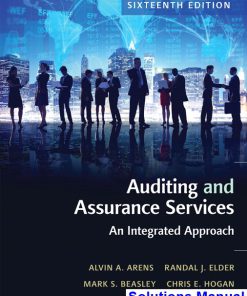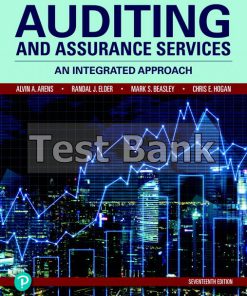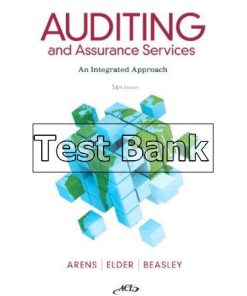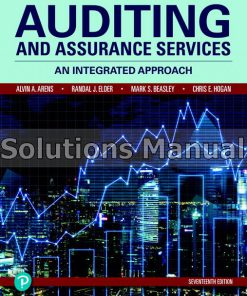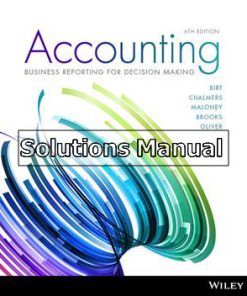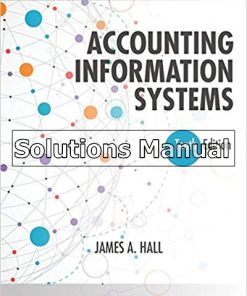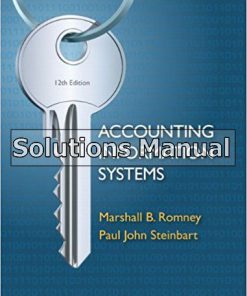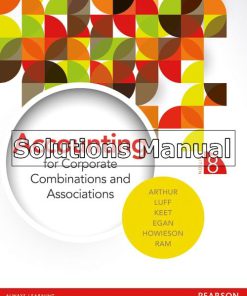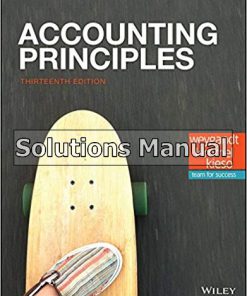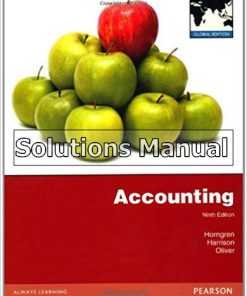Auditing and Assurance Services 15th Edition Arens Solutions Manual
$26.50$50.00 (-47%)
Auditing and Assurance Services 15th Edition Arens Solutions Manual.
You may also like
Auditing and Assurance Services 15th Edition Arens Solutions Manual

Product details:
- ISBN-10 : 0133125637
- ISBN-13 : 978-0133125634
- Author: Chris Hogan
Directed primarily toward Accounting college/university majors, this text also provides practical content to current and aspiring industry professionals.
Auditing and Assurance Services: An Integrated Approach presents an integrated concepts approach that shows readers the auditing process from start to finish. This text prepares readers for real-world audit decision making by using illustrative examples of key audit decisions, with an emphasis on audit planning, risk assessment processes and collecting and evaluating evidence in response to risks.
Table contents:
PART I INTRODUCTION TO FINANCIAL STATEMENT AUDITING 1 1 An Introduction to Assurance and Financial Statement Auditing 2 The Study of Auditing 5 The Demand for Auditing and Assurance 6 Principals and Agents 6 The Role of Auditing 7 An Assurance Analogy: The Case of the House Inspector 9 Seller Assertions, Information Asymmetry, and Inspector Characteristics 9 Desired Characteristics of the House Inspection Service 9 Relating the House Inspection Analogy to Financial Statement Auditing 10 Management Assertions and Financial Statements 11 Auditing, Attest, and Assurance Services Defined 12 Auditing 13 Attestation 14 Assurance 14 Fundamental Concepts in Conducting a Financial Statement Audit 15 Audit Risk 16 Materiality 17 Evidence Regarding Management Assertions 18 Sampling: Inferences Based on Limited Observations 18 The Audit Process 19 Overview of the Financial Statement Auditing Process 19 Major Phases of the Audit 21 Conclusion 25 Key Terms 26 Review Questions 27 Multiple-Choice Questions 28 Problems 29 Discussion Case 30 Internet Assignments 31 2 The Financial Statement Auditing Environment 34 A Time of Challenge and Change for Auditors 36 Problems and Warning Signs 36 An Explosion of Scandals 36 Government Regulation 37 Back to Basics 38 The Context of Financial Statement Auditing 38 Business as the Primary Context of Auditing 38 A Model of Business 39 Corporate Governance 39 Objectives, Strategies, Processes, Controls, Transactions, and Reports 39 A Model of Business Processes: Five Components 40 The Financing Process 40 The Purchasing Process 40 The Human Resource Management Process 40 The Inventory Management Process 40 The Revenue Process 40 Relating the Process Components to the Business Model 42 Management Assertions 42 Auditing Standards 43 The Roles of the ASB and the PCAOB 43 The 10 Generally Accepted Auditing Standards 44 Three General Standards 44 Three Standards of Field Work 45 Four Standards of Reporting 46 Statements on Auditing Standards?Interpretations of GAAS 46 Ethics, Independence, and the Code of Professional Conduct 47 The Auditor?s Responsibility for Errors, Fraud, and Illegal Acts 48 Audit Reporting 49 Generally Accepted Accounting Principles as Audit Criteria 50 The Auditor?s Standard Unqualified Audit Report 50 Reasons for Departures from an Unqualified Audit Report 52 Other Types of Audit Reports 52 Public Accounting Firms 53 Organization and Composition 53 Types of Audit, Attest, and Assurance Services 54 Audit Services 55 Attest Services 56 Assurance Services 57 Other Nonaudit Services 58 Types of Auditors 59 External Auditors 59 Internal Auditors 61 Government Auditors 61 Forensic Auditors 62 Organizations That Affect the Public Accounting Profession 62 American Institute of Certified Public Accountants (AICPA) 64 Securities and Exchange Commission (SEC) 65 Public Company Accounting Oversight Board (PCAOB) 65 Financial Accounting Standards Board (FASB) 66 Conclusion 66 Key Terms 67 Review Questions 68 Multiple-Choice Questions 69 Problems 72 Discussion Case 74 Internet Assignments 75 PART II BASIC AUDITING CONCEPTS: RISK ASSESSMENT, MATERIALITY, AND EVIDENCE 77 3 Risk Assessment and Materiality 78 Audit Risk 80 The Audit Risk Model 80 Use of the Audit Risk Model 82 The Auditor?s Risk Assessment Process 84 Management?s Strategies, Objectives, and Business Risks 84 Business Risks and the Risk of Material Misstatement 84 Understanding the Entity and Its Environment 85 Auditor?s Risk Assessment Procedures 90 Identifying Business Risks 92 Assessing the Risk of Material Misstatement Due to Error or Fraud 92 Types of Misstatements 93 Conditions Indicative of Material Misstatement Due to Fraud 94 The Fraud Risk Identification Process 95 Discussion among the Audit Team 96 Inquiries of Management and Others 97 Fraud Risk Factors 97 The Auditor?s Response to the Results of the Risk Assessments 102 Evaluation of Audit Test Results 104 Documentation of the Auditor?s Risk Assessment and Response 105 Communications about Fraud to Management, the Audit Committee, and Others 107 Limitations of the Audit Risk Model 109 Materiality 109 Steps in Applying Materiality 110 An Example 116 Key Terms 118 Review Questions 119 Multiple-Choice Questions 119 Problems 121 Discussion Cases 123 Internet Assignments 125 4 Audit Evidence and Audit Documentation 130 The Relationship of Audit Evidence to the Audit Report 132 Management Assertions 133 Assertions about Classes of Transactions and Events during the Period 134 Assertions about Account Balances at the Period End 134 Assertions about Presentation and Disclosure 135 Audit Procedures 136 The Concepts of Audit Evidence 137 The Nature of Audit Evidence 138 The Competence of Audit Evidence 138 The Sufficiency of Audit Evidence 140 The Evaluation of Audit Evidence 140 Audit Procedures for Obtaining Audit Evidence 141 Inspection of Records or Documents 141 Inspection of Tangible Assets 142 Reperformance 143 Recalculation 143 Scanning 143 Inquiry 143 Observation 144 Confirmation 145 Analytical Procedures 145 Reliability of the Types of Evidence 146 Audit Documentation 147 Objectives of Audit Documentation 147 Content of Audit Documentation 147 Examples of Audit Documentation 149 Format of Audit Documentation 151 Organization of Audit Documentation 152 Ownership of Audit Documentation 154 Audit Document Archiving and Retention 154 Key Terms 155 Review Questions 157 Multiple-Choice Questions 157 Problems 159 Discussion Cases 161 Internet Assignments 163 PART III PLANNING THE AUDIT, AND UNDERSTANDING AND AUDITING INTERNAL CONTROL 165 5 Audit Planning and Types of Audit Tests 166 Client Acceptance and Continuance 168 Prospective Client Acceptance 168 Continuing Client Retention 170 Establishing the Terms of the Engagement 170 The Engagement Letter 170 Internal Auditors 170 The Audit Committee 175 Preplanning 176 Determine the Audit Engagement Team Requirements 176 Assess Independence 176 Assess Risks and Establish Materiality 177 Planning the Audit 177 Assess a Preliminary Level for Control Risk by Account and Assertion 178 Assess the Possibility of Illegal Acts 178 Identify Related Parties 179 Conduct Preliminary Analytical Procedures 180 Develop an Overall Audit Strategy and Prepare Audit Programs 181 Consider Additional Value-Added Services 182 Types of Audit Tests 183 Risk Assessment Procedures 183 Tests of Controls 183 Substantive Procedures 184 Dual Purpose Tests 185 Substantive Analytical Procedures 185 Analytical Procedures 185 Purposes of Analytical Procedures 185 Substantive Analytical Procedures Decision Process 186 Final Analytical Procedures 198 The Audit Testing Hierarchy 199 An ?Assurance Bucket? Analogy 201 Advanced Module: Selected Financial Ratios 203 Selected Financial Ratios Useful as Analytical Procedures 203 Short-Term Liquidity Ratios 203 Activity Ratios 204 Profitability Ratios 205 Coverage Ratios 206 Key Terms 206 Review Questions 207 Multiple-Choice Questions 208 Problems 211 Discussion Cases 215 Internet Assignments 217 6 Internal Control in a Financial Statement Audit 218 Introduction 220 Internal Control 220 Definition of Internal Control 220 Controls Relevant to the Audit 220 Components of Internal Control 221 The Effect of Information Technology on Internal Control 222 Planning an Audit Strategy 223 Substantive Strategy 226 Reliance Strategy 226 Obtain an Understanding of Internal Control 228 Overview 228 Control Environment 229 The Entity?s Risk Assessment Process 232 Information Systems and Communication 234 Control Procedures 235 Monitoring of Controls 236 The Effect of Entity Size on Internal Control 237 The Limitations of an Entity?s Internal Control 237 Documenting the Understanding of Internal Control 239 Assessing Control Risk 240 Identifying Specific Controls That Will Be Relied Upon 241 Performing Tests of Controls 241 Concluding on the Achieved Level of Control Risk 242 Documenting the Assessed Level of Control Risk 242 An Example 242 Substantive Procedures 243 Timing of Audit Procedures 244 Interim Tests of Controls 245 Interim Substantive Procedures 245 Auditing Accounting Applications Processed by Service Organizations 246 Communication of Internal Control?Related Matters 247 Advanced Module 1: Types of Controls in an IT Environment 249 General Controls 249 Application Controls 251 Advanced Module 2: Flowcharting Techniques 254 Symbols 254 Organization and Flow 255 Key Terms 256 Review Questions 257 Multiple-Choice Questions 257 Problems 260 Discussion Case 262 Internet Assignments 263 7 Auditing Internal Control over Financial Reporting in Conjunction with an Audit of Financial Statements 264 Management Responsibilities under Section 404 266 Auditor Responsibilities under Section 404 266 Internal Control over Financial Reporting Defined 267 Internal Control Deficiencies Defined 267 Control Deficiency 267 Significant Deficiency 268 Material Weakness 268 Likelihood and Magnitude 268 Management?s Assessment Process 269 Management?s Documentation 271 Framework Used by Management to Conduct Its Assessment 272 Performing an Audit of Internal Control over Financial Reporting 272 The Audit Process 272 Planning the Engagement 273 Evaluating Management?s Assessment Process 273 Obtaining an Understanding of Internal Control over Financial Reporting 274 Evaluting Design Effectiveness of Controls 279 Testing and Evaluating Operating Effectiveness of Controls 279 Forming an Opinion on the Effectiveness of Internal Control over Financial Reporting 284 Written Representations 286 Auditor Documentation Requirements 286 Reporting on Internal Control over Financial Reporting 287 Management?s Report 287 The Auditor?s Report 288 Additional Required Communications in an Audit of Internal Control over Financial Reporting 294 Integrating the Audits of Internal Control and Financial Statements 295 Effect of the Audit of Internal Control on the Financial Statement Audit 295 Effect of the Financial Statement Audit on the Audit of Internal Control 296 Advanced Module 1: Special Considerations for an Audit of Internal Control 297 Using the Work of Others 297 Testing Internal Control When a Company Has Multiple Locations or Business Units 299 Use of Service Organizations 301 Safeguarding of Assets 303 Advanced Module 2: Computer-Assisted Audit Techniques 303 Generalized Audit Software 304 Custom Audit Software 305 Test Data 305 Key Terms 306 Review Questions 307 Multiple-Choice Questions 308 Problems 310 Internet Assignments 315 PART IV STATISTICAL AND NONSTATISTICAL SAMPLING TOOLS FOR AUDITING 317 8 Audit Sampling: An Overview and Application to Tests of Controls 318 Introduction 320 Definitions and Key Concepts 322 Audit Sampling 322 Sampling Risk 322 Confidence Level 323 Tolerable and Expected Error 324 Audit Evidence Choices That Do and Do Not Involve Sampling 324 Types of Audit Sampling 326 Nonstatistical versus Statistical Sampling 326 Types of Statistical Sampling Techniques 327 Attribute Sampling Applied to Tests of Controls 328 Planning 328 Population Size 334 Performance 334 Sample Selection 334 Evaluation 337 An Example of an Attribute-Sampling Plan 339 Determine the Test Objective (Step 1) 339 Define the Population Characteristics (Step 2) 339 Determine the Sample Size (Step 3) 340 Select Sample Items (Step 4) 342 Perform the Audit Procedures (Step 5) 343 Calculate the Sample Deviation and the Computed Upper Deviation Rates (Step 6) 346 Draw Final Conclusions (Step 7) 347 Nonstatistical Sampling for Tests of Controls 349 Determining the Sample Size 349 Selecting the Sample Items 350 Calculating the Computed Upper Deviation Rate 350 Advanced Module: Considering the Effect of the Population Size 351 Key Terms 352 Review Questions 353 Multiple-Choice Questions 353 Problems 356 Discussion Case 359 9 Audit Sampling: An Application to Substantive Tests of Account Balances 362 Sampling for Substantive Tests of Details of Account Balances 364 Monetary-Unit Sampling 365 Advantages 366 Disadvantages 366 Applying Monetary-Unit Sampling 367 Planning 367 Computing Sample Sizes Using the Attribute-Sampling Tables 371 Computing Sample Sizes Using ACL 371 Performance 372 Evaluation 374 An Extended Example 374 Basic Precision 375 Misstatements Detected 376 Compute the Upper Misstatement Limit 377 Computing Projected Upper Misstatement Using ACL 379 Nonstatistical Sampling for Tests of Account Balances 384 Identifying Individually Significant Items 384 Determining the Sample Size 385 Selecting Sample Items 385 Calculating the Sample Results 386 An Example of Nonstatistical Sampling 387 The Rise and Fall of Statistical Audit Sampling 388 Advanced Module: Classical Variables Sampling 389 Advantages 392 Disadvantages 392 Applying Classical Variables Sampling 392 Key Terms 397 Review Questions 398 Multiple-Choice Questions 398 Problems 400 Discussion Cases 404 PART V AUDITING BUSINESS PROCESSES 407 10 Auditing the Revenue Process 408 Revenue Recognition 411 Overview of the Revenue Process 412 Types of Transactions and Financial Statement Accounts Affected 413 Types of Documents and Records 416 The Major Functions 420 Key Segregation of Duties 422 Inherent Risk Assessment 423 Industry-Related Factors 423 The Complexity and Contentiousness of Revenue Recognition Issues 424 The Difficulty of Auditing Transactions and Account Balances 424 Misstatements Detected in Prior Audits 424 Control Risk Assessment 424 Understanding and Documenting Internal Control 425 Planning and Performing Tests of Controls 426 Setting and Documenting the Control Risk 427 Control Procedures and Tests of Controls?Revenue Transactions 427 Occurrence of Revenue Transactions 429 Completeness of Revenue Transactions 430 Authorization of Revenue Transactions 431 Accuracy of Revenue Transactions 431 Cutoff of Revenue Transactions 431 Classification of Revenue Transactions 432 Control Procedures and Tests of Controls?Cash Receipts Transactions 432 Occurrence of Cash Receipts Transactions 432 Completeness of Cash Receipts Transactions 432 Authorization of Cash Discounts 434 Accuracy of Cash Transactions 434 Cutoff of Cash Receipts Transactions 435 Classification of Cash Receipts 435 Control Procedures and Tests of Controls? Sales Returns and Allowances Transactions 435 Relating the Assessed Level of Control Risk to Substantive Procedures 436 Auditing Accounts Receivable and Related Accounts 436 Substantive Analytical Procedures 437 Tests of Details of Classes of Transactions, Account Balances, and Disclosures 439 Completeness 439 Cutoff 442 Existence 444 Rights and Obligations 444 Valuation and Allocation 444 Classification and Understandability 445 Other Presentation and Disclosure Assertions 445 The Confirmation Process?Accounts Receivable 446 Types of Confirmations 448 Timing 449 Confirmation Procedures 450 Alternative Procedures 451 Auditing Other Receivables 452 Evaluating the Audit Findings?Accounts Receivable and Related Accounts 452 Key Terms 453 Review Questions 454 Multiple-Choice Questions 454 Problems 457 Discussion Cases 462 Internet Assignments 463 11 Auditing the Purchasing Process 466 Expense and Liability Recognition 468 Overview of the Purchasing Process 468 Types of Transactions and Financial Statement Accounts Affected 469 Types of Documents and Records 471 The Major Functions 473 The Key Segregation of Duties 475 Inherent Risk Assessment 476 Industry-Related Factors 476 Misstatements Detected in Prior Audits 477 Control Risk Assessment 477 Understanding and Documenting Internal Control 477 Planning and Performing Tests of Controls 479 Setting and Documenting Control Risk 479 Control Procedures and Tests of Controls? Purchase Transactions 479 Occurrence of Purchase Transactions 480 Completeness of Purchase Transactions 480 Authorization of Purchase Transactions 482 Accuracy of Purchase Transactions 483 Cutoff of Purchase Transactions 483 Classification of Purchase Transactions 483 Control Procedures and Tests of Controls?Cash Disbursement Transactions 484 Occurrence of Cash Disbursement Transactions 484 Completeness of Cash Disbursement Transactions 484 Authorization of Cash Disbursement Transactions 484 Accuracy of Cash Disbursement Transactions 486 Cutoff of Cash Disbursement Transactions 486 Classification of Cash Disbursement Transactions 486 Control Procedures and Tests of Controls?Purchase Return Transactions 487 Relating the Assessed Level of Control Risk to Substantive Procedures 487 Auditing Accounts Payable and Accrued Expenses 488 Substantive Analytical Procedures 489 Tests of Details of Classes of Transactions, Account Balances, and Disclosures 489 Completeness 489 Existence 492 Cutoff 492 Rights and Obligations 493 Valuation 493 Classification and Understandability 493 Other Presentation Disclosure Assertions 494 Accounts Payable Confirmations 494 Evaluating the Audit Findings?Accounts Payable and Related Accounts 496 Key Terms 497 Review Questions 497 Multiple-Choice Questions 498 Problems 500 Discussion Case 503 Internet Assignments 504 12 Auditing the Human Resource Management Process 506 Overview of the Human Resource Management Process 508 Types of Transactions and Financial Statement Accounts Affected 508 Types of Documents and Records 509 The Major Functions 511 The Key Segregation of Duties 512 Inherent Risk Assessment 513 Control Risk Assessment 514 Understanding and Documenting Internal Control 515 Planning and Performing Tests of Controls 515 Setting and Documenting the Control Risk 516 Control Procedures and Tests of Controls?Payroll Transactions 516 Occurrence of Payroll Transactions 516 Authorization of Payroll Transactions 516 Accuracy of Payroll Transactions 518 Classification of Payroll Transactions 518 Relating the Assessed Level of Control Risk to Substantive Procedures 519 Auditing Payroll-Related Accounts 519 Substantive Analytical Procedures 520 Tests of Details of Classes of Transactions, Account Balances, and Disclosures 520 Payroll Expense Accounts 522 Accrued Payroll Liabilities 522 Evaluating the Audit Findings?Payroll-Related Accounts 525 Key Terms 525 Review Questions 526 Multiple-Choice Questions 527 Problems 528 Discussion Cases 533 Internet Assignment 534 13 Auditing the Inventory Management Process 536 Overview of the Inventory Management Process 538 Types of Documents and Records 538 The Major Functions 541 The Key Segregation of Duties 543 Inherent Risk Assessment 543 Industry-Related Factors 544 Engagement and Operating Characteristics 544 Control Risk Assessment 546 Understanding and Documenting Internal Control 546 Planning and Performing Tests of Controls 547 Setting and Documenting the Control Risk 547 Control Procedures and Tests of Controls?Inventory Transactions 547 Occurrence of Inventory Transactions 547 Completeness of Inventory Transactions 549 Authorization of Inventory Transactions 549 Accuracy of Inventory Transactions 549 Classification of Inventory Transactions 550 Relating the Assessed Level of Control Risk to Substantive Procedures 550 Auditing Inventory 551 Substantive Analytical Procedures 551 Auditing Standard Costs 552 Materials 552 Labor 552 Overhead 552 Observing Physical Inventory 553 Tests of Details of Classes of Transactions, Account Balances, and Disclosures 554 Accuracy 554 Cutoff 556 Existence 556 Completeness 556 Rights and Obligations 556 Valuation and Allocation 557 Classification and Understandability 557 Other Presentation and Disclosure Assertions 557 Evaluating the Audit Findings?Inventory 558 Key Terms 559 Review Questions 559 Multiple-Choice Questions 560 Problems 562 Discussion Case 567 Internet Assignments 567 14 Auditing Financing Process: Prepaid Expenses and Property, Plant, and Equipment 568 Auditing Prepaid Expenses 570 Inherent Risk Assessment?Prepaid Expenses 570 Control Risk Assessment?Prepaid Expenses 571 Substantive Procedures?Prepaid Insurance 571 Substantive Analytical Procedures 571 Tests of Details of the Prepaid Insurance Account 571 Auditing the Property Management Process 573 Types of Transactions 574 Overview of the Property Management Process 575 Inherent Risk Assessment?Property Management Process 575 Complex Accounting Issues 575 Difficult-to-Audit Transactions 575 Misstatements Detected in Prior Audits 577 Control Risk Assessment?Property Management Process 577 Occurrence and Authorization 577 Completeness 578 Segregation of Duties 579 Substantive Procedures?Property, Plant, and Equipment 579 Substantive Analytical Procedures?Property, Plant, and Equipment 579 Tests of Details of Transactions, Account Balances, and Disclosures?Property, Plant, and Equipment 580 Completeness 580 Cutoff 581 Classification 581 Existence 581 Rights and Obligations 583 Valuation and Allocation 583 Disclosure Issues 583 Evaluating the Audit Findings?Property, Plant, and Equipment 584 Key Terms 584 Review Questions 585 Multiple-Choice Questions 585 Problems 588 Discussion Case 590 Internet Assignments 591 15 Auditing Financing Process: Long-Term Liabilities, Stockholders? Equity, and Income Statement Accounts 592 Auditing Long-Term Debt 594 Control Risk Assessment?Long-Term Debt 595 Assertions and Related Control Procedures 595 Substantive Procedures of Long-Term Debt 596 Auditing Stockholders? Equity 599 Control Risk Assessment?Stockholders? Equity 599 Assertions and Related Control Procedures 600 Segregation of Duties 601 Auditing Capital-Stock Accounts 601 Occurrence and Completeness 601 Valuation 601 Completeness of Disclosures 602 Auditing Dividends 602 Auditing Retained Earnings 602 Auditing Income Statement Accounts 603 Assessing Control Risk for Business Processes 603 Direct Tests of Balance Sheet Accounts 604 Substantive Analytical Procedures 604 Tests of Selected Account Balances 605 Key Terms 606 Review Questions 606 Multiple-Choice Questions 607 Problems 608 Discussion Case 610 Internet Assignment 612 16 Auditing Financing Process: Cash and Investments 614 Cash and the Effect of Other Business Processes 616 Types of Bank Accounts 617 General Cash Account 617 Imprest Cash Accounts 617 Branch Accounts 618 Substantive Analytical Procedures?Cash 618 Substantive Tests of Details of Transactions and Balances 618 The Effects of Controls 618 Balance-Related Assertions 619 Auditing the General Cash Account 620 Fraud-Related Audit Procedures 624 Auditing a Payroll or Branch Imprest Account 627 Auditing a Petty Cash Fund 627 Disclosure Issues for Cash 628 Investments 630 Control Risk Assessment?Investments 630 Assertions and Related Control Procedures 630 Segregation of Duties 632 Substantive Procedures for Testing Investments 632 Existence 633 Valuation and Allocation 634 Disclosure Assertions 634 Key Terms 635 Review Questions 635 Multiple-Choice Questions 636 Problems 638 Internet Assignment 643 PART VI COMPLETING THE AUDIT AND REPORTING RESPONSIBILITIES 645 17 Completing the Engagement 646 Review for Contingent Liabilities 648 Audit Procedures for Identifying Contingent Liabilities 649 Legal Letters 650 Commitments 652 Review for Subsequent Events for Audit of Financial Statements 653 Dual Dating 654 Audit Procedures for Subsequent Events 655 Review of Subsequent Events for Audit of Internal Control over Financial Reporting 655 Final Evidential Evaluation Processes 656 Final Analytical Procedures 656 Going-Concern Considerations 657 Representation Letter 659 Working Paper Review 660 Evaluating Financial Audit Results 660 Evaluating Financial Statement Presentation and Disclosure 664 Independent Partner Review 664 Archiving and Retention 664 Communications with the Audit Committee and Management 665 Audit of Internal Control over Financial Reporting 665 Subsequent Discovery of Facts Existing at the Date of the Auditor?s Report 666 Key Terms 667 Review Questions 668 Multiple-Choice Questions 669 Problems 671 Discussion Cases 676 Internet Assignments 679 18 Reports on Audited Financial Statements and on Internal Control over Financial Reporting 680 Reporting on the Financial Statement Audit: The Standard Unqualified Audit Report 682 Explanatory Language Added to the Standard Unqualified Financial Statement Audit Report 683 Opinion Based in Part on the Report of Another Auditor 683 Going Concern 685 Auditor Agrees with a Departure from Promulgated Accounting Principles 686 Lack of Consistency 686 Emphasis of a Matter 687 Departures from an Unqualified Financial Statement Audit Report 687 Conditions for Departure 688 Other Types of Financial Statement Audit Reports 689 The Effect of Materiality on Financial Statement Audit Reporting 689 Discussion of Conditions Requiring Other Types of Financial Statement Audit Reports 690 Scope Limitation 690 Statements Not in Conformity with GAAP 691 Auditor Not Independent 693 Special Reporting Issues 694 Reports on Comparative Financial Statements 694 Different Reports on Comparative Financial Statements 694 A Change in Report on the Prior-Period Financial Statements 695 Report by a Predecessor Auditor 696 Other Information in Documents Containing Audited Financial Statements 697 Special Reports Relating to Financial Statements 697 Financial Statements Prepared on a Comprehensive Basis of Accounting Other Than GAAP 698 Specified Elements, Accounts, or Items of a Financial Statement 699 Compliance Reports Related to Audited Financial Statements 701 Reporting on the Audit of Internal Control over Financial Reporting 702 The Auditor?s Opinion on Management?s Assessment 702 The Auditor?s Opinion on the Effectiveness of Internal Control over Financial Reporting 703 Unqualified Report 704 Modifications to the Unqualified Report on the Effectiveness of Internal Control 704 Key Terms 710 Review Questions 710 Multiple-Choice Questions 711 Problems 715 Discussion Cases 719 PART VII PROFESSIONAL RESPONSIBILITIES 725 19 Professional Conduct, Independence, and Quality Control 726 Ethics and Professional Conduct 728 Ethics and Professionalism Defined 728 Theories of Ethical Behavior 729 Example?An Ethical Dilemma 730 Development of Moral Judgment 733 An Overview of Ethics and Professionalism in Public Accounting 734 A Tale of Two Companies 734 Standards for Auditor Professionalism 735 The AICPA Code of Professional Conduct: A Comprehensive Framework for Auditors 737 Principles of Professional Conduct 737 Rules of Conduct 739 Independence, Integrity, and Objectivity 742 Independence 742 Integrity and Objectivity 756 General Standards and Accounting Principles 757 General Standards and Compliance with Standards 757 Accounting Principles 758 Responsibilities to Clients 759 Confidential Client Information 759 Contingent Fees 760 Other Responsibilities and Practices 760 Acts Discreditable 760 Advertising and Other Forms of Solicitation 761 Commissions and Referral Fees 762 Form of Organization and Name 762 Disciplinary Actions 763 Don?t Lose Sight of the Forest for the Trees 763 Quality Control Standards 763 System of Quality Control 764 Elements of Quality Control 764 Monitoring Quality Control 765 PCAOB Inspections of Registered Public Accounting Firms 766 Key Terms 767 Review Questions 768 Multiple-Choice Questions 769 Problems 772 Discussion Cases 775 Internet Assignments 776 20 Legal Liability 778 Introduction 780 Historical Perspective 780 Overview 780 Common Law?Clients 782 Breach of Contract 783 Negligence 784 Fraud 786 Common Law?Third Parties 786 Negligence 787 Example 1 790 Example 2 790 Example 3 791 Fraud 792 Damages under Common Law 793 Statutory Liability 794 Securities Act of 1933 794 Securities Exchange Act of 1934 796 Private Securities Litigation Reform Act of 1995 and the Securities Litigation Uniform Standards Act of 1998 799 Sarbanes-Oxley Act of 2002 800 SEC and PCAOB Sanctions 801 Foreign Corrupt Practices Act 802 Racketeer Influenced and Corrupt Organizations Act 802 Criminal Liability 803 Approaches to Minimizing Legal Liability 805 At the Profession Level 805 At the Firm Level 806 Advanced Module: A View of an Accounting Fraud and Litigation from inside the Courtroom 807 What the Jury Heard in the Phar-Mor Case 807 What Can Be Learned? 814 Key Terms 814 Review Questions 815 Multiple-Choice Questions 816 Problems 819 Discussion Cases 823 PART VIII ASSURANCE, ATTESTATION, AND INTERNAL AUDITING SERVICES 825 21 Assurance, Attestation, and Internal Auditing Services 826 Assurance Services 828 Types of Assurance Services 829 Attest Engagements 830 Types of Attest Engagements 831 Attestation Standards 832 General Standards 832 Standards of Field Work 834 Standards of Reporting 834 Reporting on an Entity?s Internal Control over Financial Reporting 834 Conditions for Conducting an Engagement 834 Examination Engagement 835 Reporting on Management?s Assertion about Internal Control 836 Financial Forecasts and Projections 836 Types of Prospective Financial Statements 836 Examination of Prospective Financial Statements 837 Agreed-Upon Procedures for Prospective Financial Statements 839 Compilation of Prospective Financial Statements 839 Accounting and Review Services 841 Compilation of Financial Statements 842 Compilation with Full Disclosure 842 Compilation That Omits Substantially All Disclosures 843 Compilation When the Accountant Is Not Independent 843 Review of Financial Statements 843 Review Report 844 Conditions That May Result in Modification of a Compilation or Review Report 845 Internal Auditing 846 Internal Auditing Defined 846 The Institute of Internal Auditors 846 IIA Standards 847 Code of Ethics 847 Internal Auditors? Roles 847 Internal Audit Product Offerings 852 Interactions between Internal and External Auditors 853 Advanced Module: Examples of Assurance Services?Trust Services and PrimePlus Services 854 Trust Services 854 CPA WebTrust 855 SysTrust 857 CPA PrimePlus Services 857 Key Terms 860 Review Questions 861 Multiple-Choice Questions 862 Problems 864 Discussion Case 869 Internet Assignments 869 Index 871
People also search:
auditing and assurance services 15th edition pdf free download
auditing and assurance services 15th edition test bank pdf
auditing and assurance services an integrated approach 15th edition
what is auditing and assurance services
|
examples of assurance services in auditing
|

